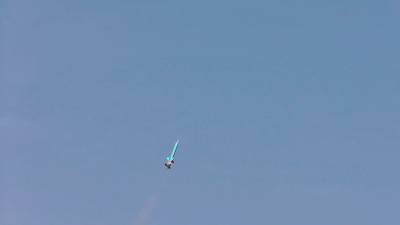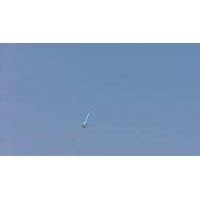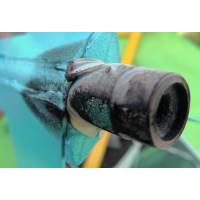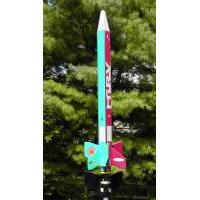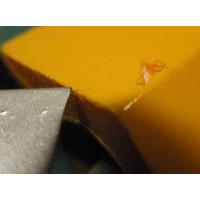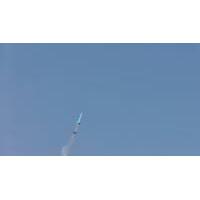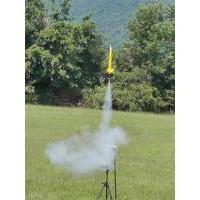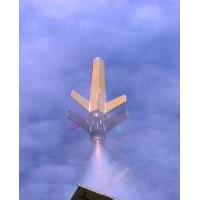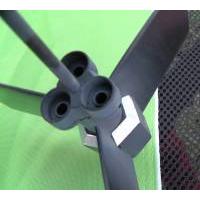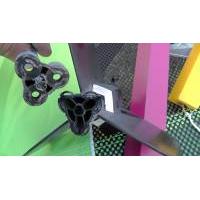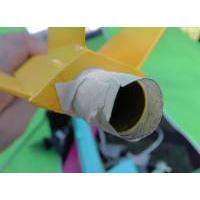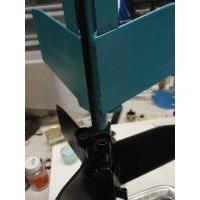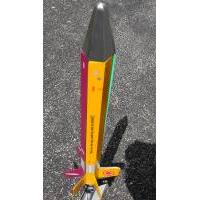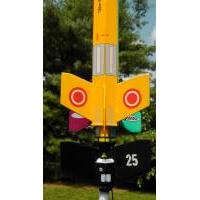| Construction Rating: | starstarstarstar_borderstar_border |
| Flight Rating: | starstarstarstar_borderstar_border |
| Overall Rating: | starstarstarstarstar_border |
| Published: | 2013-06-27 |
| Diameter: | 1.64 inches |
| Length: | 24.50 inches |
| Manufacturer: | Estes  |
| Skill Level: | 3 |
| Style: | Multi-Stage |
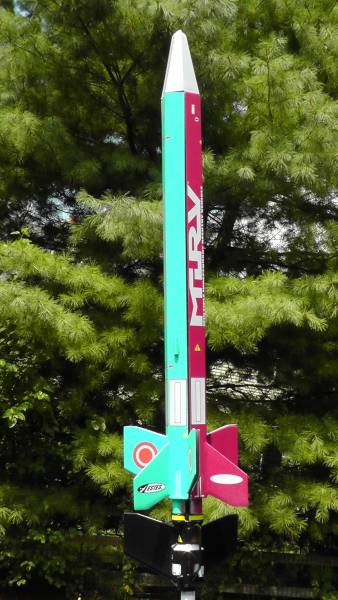 Brief
Brief
MIRV is short for Multiple Independant Reentry Vehicle. The MIRV is a unique two-stage rocket from Estes that has three simultaneously firing second stages. The booster is an 18mm B6 or C6, and the three second stages use the mini 13mm A10-3T. The first booster stage fires and lifts all stages. Then it launches three individual rockets that travel seperately. While not a totally new concept, it is certainly a departure from normal single or two-stage rockets. It was that difference that motivated me to try this rocket out, to be a pioneer in a whole new area of rocketry.
It is not a very large rocket. It stands just over two feet tall, and weighs about 4 oz without motors. Both the booster stage and the upper stages recover with tumble recovery. No parachute or streamer is necessary but I suppose you could add small ones if you wish. The upper stages are just over an ounch each (sans motors). The styling of the rocket is pretty cool looking, although I didn't paint it as suggested on the kit artwork, I used bright contrasting colors with silver nose cones. Technically, it does work as advertized, but I did find a few problems with the kit that are not insurmountable. It seems to me that the design could use some refinement.
Components
Expect the typical quality from Estes, which is pretty good. The body tubes are very good although you don't see them in the finished rocket, the balsa also very good, and the water-slide decals look great and go on well. As usual, the shock cord rubber is too short and the mounting method leaves much to be desired.
About the only big gripe I had was the styrofoam used on the second stages. The foam is soft and easily marred. Having received the kit with the parts in a plastic bag, they were pretty well beat up. I have seen plenty of kits from Estes packaged in a sturdy cardboard box, they should have done that to this kit because of the delicate foam. Not only were there dings and knicks from external contact, but there were ring-shaped depressions and scrapes made from some of the other parts in the kit. Estes failed here with the packaging, you don't need to be a rocket scientist to know not to let a bull in a china shop.
The light styrofoam is a good idea design-wise though, it serves to shape the three upper stage bodies so they fit together as a single unit instead of three distinct tubes. This was certianly a simpler and lighter method than using paper/cardboard or balsa wood to achieve the same effect, but it has it's drawbacks. There was also another piece of styrofoam for the booster stage.
Note that the styrofoam can be dissolved by some types of glues and paints, so be sure to test a drop or two before using it on the foam. I tried using Testor's Model Master paints, which did not have any problems and appeared to coat well even without a primer, although it is an expensive paint. You shouldn't have a problem with normal wood glue, but I would test that anyways just to be sure.
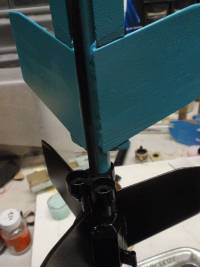
Construction
There were not a lot of very challenging steps to the assembly of the MIRV. The instructions do clearly show you how to assemble it. I suppose the most challenging steps for me was the gluing, sanding and finishing of twelve fins - a lot more than your average 3 or 4 fin rocket. What did make the construction easier was that the fins were attached with the styrofoam in place which acted as a built-in fin alignment jig so there was no difficulty in aligning any of the twelve fins.
Some of the fins required assembly from two seperate pieces butt-jointed together. I don't know why, maybe the differing grain direction makes them stronger/stiffer, but otherwise they were small enough to have easily been made from a single piece of balsa.
There are challenges to this kit construction though, which I think is the result of compensating for a design that still needs some refinement in my opinion. I recommend doing a few things that are not covered in the basic kit. Most importantly, if I were to build another one, I would increase the length of the wood dowel used as a launch rail for the upper stages, and move the upper stage's launch lugs as far forward as possible, so that it will better hold the three nose cones together when they are on the booster. Of course, that would mean the upper stages pop off the rod rather quickly after ignition, but the booster stage already gets these rockets up to speed for the fins to be effective so I think they would continue to safely travel upwards anyways. Pretty much every other multi-stage rocket works fine without a launch rail on the booster.
You could use longer or split lugs to solve that problem, but if one stage does not ignite then they will interfere with the others and you may have a flying mess on your hands. Perhaps three independent thinner rods would have worked better - but that would of course be heavier and more complex.
The upper stages are constructed from a BT-5 tube and shaped with an outer wrap of styrofoam to make a flattened-diamond cross section when fit together. The three diamond sections fit together to make a larger hexagon when all three stages are assembled for flight. The foam, pretty beat-up from shipping, needed some filler and sanding to make a smooth surface again. I hoped that layers of primer and paint would provide somewhat of a harder shell, but that was not the case and the finished product is still very easily dinged and punctured.
I did almost have a construction mishap though. When gluing the booster's motor tube into the plastic manifold, I hesitated just a bit and the glue caught before I could seat the tube all the way in. I pushed as hard as I could but could not make the last 3/16". I was worried about upper-stage ignition reliability but it turned out I had no problem with the small gap ...yet.
One major thing I learned from experience: Sand and fillercoat the fins BEFORE gluing them into the rocket with the foam. The foam is very delicate and with all that sanding you are bound to scrape and ding the styrofoam somewhere. Just remember to sand away the balsa fillercoat where you will apply glue. I would recommend paper laminating the fin surfaces for better smoothness and a bit more strength.
Another step in the assembly involves gluing two plastic pieces together to form the manifold. This critical piece is used to duct the flame from the lower to the upper stages. When you stage that way ("gap staging"), you must allow for the existing cool air in the manifold to escape to allow the flaming pressure from the booster motor to travel to the upper nozzles, so a small vent is needed near the upper stage to let the cool air out of the way. This small vent - nearly invisible - is molded into the plastic pieces at the joint. When gluing them together, Estes warns you to not use too much glue and so I did not (I suspect to prevent over-glue from blocking the tiny vent holes). Of course that was the first broken glue joint on the first flight, so I say use A LOT of glue, just make sure that the tiny vent holes are clear. It appears to be some kind of thermoset plastic, so maybe normal plastic cement does not work well here (it's actually made to chemically melt and weld styrene plastic). You might want to try either CA or epoxy glue, so let me know if that works better, I have a feeling I will be gluing it again!
You will notice the rather unique sharp triangle/diamond shapes of the three nosecones. Each nose cone is assembled from two pieces to form a single nose cone. These pieces are relatively heavy and probably allow for a balanced model. The three diamond shapes fit together to form a hexagonal nosecone. Unfortunately, as individual nose cones there are a lot of sharp corners. When these nose cones snap back from the Estes-short shock cord after ejection, they are perfectly shaped to make a nasty ding in the delicate styrofoam bodies, and as expected I now have little dings. You may want to experiment with longer shock cords, or long Kevlar cords instead of the normal rubber.
Mounting the shock cords using Estes normal paper-fold method was also very difficult as my fingers are too small to fit down into the BT-5 tube past the shoulder length of the nose cones. Instead, I glued in small Kevlar loops in there, with the ends of the Kevlar frayed to make for a much wider gluing surface. I have done this with at least three or four other models now, and none of them have broken/seperated in repeated flights. The loop allows me to change out the shock cord rubber when necessary.
Finishing
Finishing went OK, no major problems, but you do have to make sure to use a compatible paint or you just might have to watch your model disolve right before your eyes. I used Testor's Model Master paints with no problems, and skipped the primer to keep it light and it still covered well.
If I had to do it all over again, I might try to coat the foam upper stages with a thinned white glue to build up a stiffer shell over the foam. My rocket surface is soft and suffering the dings from handling and the recoil of those sharp nose cones.
I can't rate this kit very high for construction and finishing, because I feel that Estes could have given us more tips to make the rocket and the construction better, but did not. In part because I think the design still needs some tweaking.

Flight
She flew very well on the maiden flight! Impressive and fun, but there were problems I noticed afterwards. First, it was time consuming to friction-fit and load all three upper stage motors, add wadding, stuff the shock rubber and assemble the stages. The upper stages don't want to stay tightly together by themselves, and I was worried the 50-100mph airflow at launch would blow between the upper stages and rip them apart, so I used a small bit of celophane tape to hold the tip of the nosecones together.
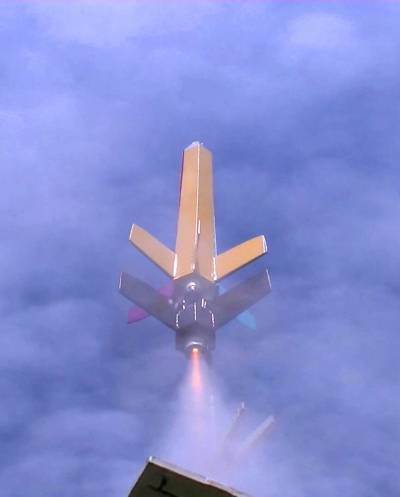
The flight(s) was unique and enjoyable, but the rockets came back with charred ends and the booster manifold was broken and the booster covered in soot. The booster did land on the launch control tent, so that may have contributed to the break. Even though, you will someday encounter rocks, cars, sidewalks, and other hard surfaces in your field of flight.
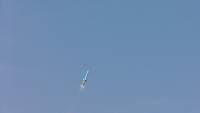
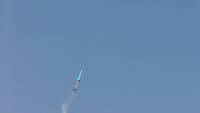
The two plastic pieces of the manifold separated at the glue joint - easily re-glued but that meant the end of flights for the day while the glue dries. That is why I recommend using a lot of glue, but making sure the vent holes are open. The top piece of the manifold holds the wood dowel that acts as a launch rod for the upper stages, so the lever action of the dowel hitting first probably places a lot of load on the glue joint. It would have been a better design if the dowel passed through the upper manifold part and into the lower part to re-inforce the glue joint.
Estes warns the user to clean out the plastic manifold with soapy wet cloth from time to time, as soot and ash will build up and eventually prevent upper stage ignition. The combined exhaust of the three upper stages covered the booster stage in black greasy soot, so if you want a clean booster exterior you will have to carry a spray bottle of grease-cutting cleaner and some towels with you.
Fortunately I didn't see any sign of charring or burning on the booster. Small reflective foil squares supplied by Estes may have helped here to protect the booster's styrofoam.
The upper stages were not so lucky. I would normally friction-fit a motor into the rocket using masking tape on the motor casing. It allows me to adjust the friction fit well. Estes instructs you to fit the upper motors by taping the protruding end of the motor to the outside of the rocket. OK, I did that. This did solve my concern about the upper stages fitting too losely in the manifold, but it left the masking tape exposed to being charred and burned by the other upper stages when they ignited.
The burn of the exposed masking tape ruined the finish a bit and made the tape almost impossible to clean off of all three upper-stages and remove because of the burned tape and adhesive gunk. The #2 upper-stage had some of the fin balsa charred and burned too. Also, the #3 upper stage motor blew out upon ejection, so the external tape method does not guarantee a firm fit. Fortunately for that stage the nose cone popped off before the motor won its freedom, so the upper stage recovered normally.
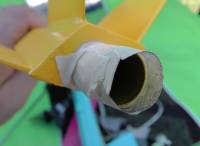
When repairing the rocket, I sanded off the burned finish and balsa areas and then sprayed the inside areas of the rocket with a high-temperature silver paint, the kind used for items like heater flues and barbeque grills. This paint is supposed to withstand 1000-1200 degrees, but we'll see if it can shrug off direct flames from rocket exhaust.
So it appears that the flight problems I had could be eliminated with construction and design. Glue the manifold well. Hi-temp spray the insides of the upper stages. Use internal tape on the motors, but be sure to add a second bit of tape on the very end of the motor casing so they fit snugly into the plastic manifold, otherwise I suspect the motor may just pop off as soon as the pressure builds and before igniting the upper stage motor.
Estes recommends the use of A10-3T motors for the upper stages. This makes sense because the upper stages will accelerate very quickly and pose less of a fligt path problem when launching from a short launch rail. The upper stages accelerated so much quicker than the speed of the booster that I had momentairly lost my tracking of the rockets with my video camera. I imagine that using the slower A3 motors or even the 1/2A motors would do well also, especially with the additional speed of a C6 booster stage, but I haven't tried it (yet!).
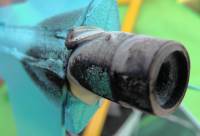
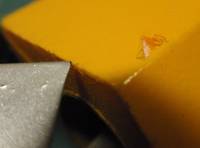

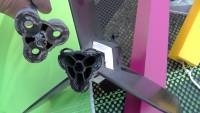
Recovery
Recovery was a blast. You do have to track three seperate rockets in addition to the booster but that is the whole strategy of independent re-entry vehicles! Mine were brightly painted and easy to spot. The silver of the nose cones glinted in the sunlight. The B6-0 booster motor didn't let them get too high. I haven't tried a C6-0 yet.
As the upper stages fall with just a shock cord to the nose cone, the rockets kind of flutter and sway while being pulled by the heavier nose cones. They are light enough to not require a parachute or streamer, and there was no damage when they hit the grass. The nose cone will create dings in the soft foam though, so if you can give it a hard shell while finishing, that may help some. Keep an eye out for the booster though, that may be harder to spot, especially in tall grass.
Although it was a fun flight to watch, the time-consuming flight prep and potential damage to the rockets made the flight and recovery less than ideal, so I have to give the MIRV a lower score for that. I feel the model could use some more design refinement.
Summary
There are several issues with the design of this kit, but they all should be solveable by an experienced rocketeer or a sharp modeler. All in all you can put it together as advertized and get at least a few fun flights out of it, and it is a very unique configuration for a multi-stage rocket. Still I think you should be warned what you are getting into.
My unforseen problems may not be a problem if you solve them before flight. This includes a hard finish on the upper stages, high-temperature paint to the inside backs, reinforce the manifold glue joint, and fit the upper stage motors without a lot of external masking tape. Don't forget to bring along the cleaner and paper towels for the booster!
If you can tweak the design to keep the noses of the upper stages tight together but let them seperate in flight, great! Not only would it look better but it would reduce drag considerably. I think having a longer launch dowel and mounting the upper lugs high on the body tube would help a lot, but since my model is already built, it's too late. I will continue to add a small bit of clear tape on the nose cones.
The packaging: Shame on you Estes. The soft foam will be marred in shipping and handling, so prepare to fill and refinish the foam parts.
Expect a lot of prep work before flight. Don't expect the rocket stages to stay tight together before launch. Expect the upper stages to char each other somewhat. Expect to have to clean off a lot of soot from the booster. Expect to track four individual rockets at the same time. If you can deal with all that, you should have a lot of fun launching a rocket like no others.
Though I would only rate this kit a 3/5, it is very unique with no competition, so that has to earn it a boost to 4/5, after all, nobody did it better.
 |
 |
Flights
Sponsored Ads
 |
 |
